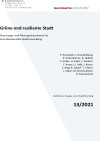Suchergebnisse
Biotope City - Bauanleitung für die grüne Stadt der Zukunft
"Biotope City" ist ein Projektleitbild für die Umsetzung umfassender urbaner Begrünung mit dem Ziel, die regenerativen Mechanismen der Natur zu nutzen. So soll die Lebensqualität umfassend, nachhaltig und kosteneffizient erhöht und Resilienz gegen Wetterextreme in Städten verbessert werden. Zentrale Zielsetzung des Projekts ist die Generierung von Bestandteilen einer realitätsgerechten, verallgemeinerbaren und übertragbaren Bauanleitung für die grüne Stadt der Zukunft.
NaNu3 - Parametrische Planung für ein Nachhaltiges Nutzdach (Blau, Grau und Grün)
Aufzeigen der Machbarkeit und Validierung eines Parametrischen Modelles, das in einem frühen Planungsstadium die kombinierte Nutzung von Dachflächen auf ihre praktische und finanzielle Umsetzbarkeit und Mikroklima- und Umweltwirksamkeit überprüfen kann.
NaNu3 - Parametric Planning for a Sustainable Roof (Blue, Grey and Green)
Demonstration of the feasibility and validation of a parametric model that can evaluate the practical and financial feasibility of the combined use of roof areas as well as its microclimate and environmental effectiveness at an early planning stage.
INReS - Integration nachhaltiger Regenwassermanagement-Tools in die Planungs- Ausführungs- und Bewirtschaftungs-Software (BIM)
Sondierung zur Vorbereitung und Bewertung der Anwendbarkeit einer interaktiven Webanwendung zur Empfehlung geeigneter Maßnahmen im Umgang mit Regenwasser im Bestand sowie bei Neubauten, die erstens eine BIM-Kompatibilität für die objekt-bezogene Umsetzung zulässt und zweitens eine vereinfachte Anwendung in Form der Regenwasser-Toolbox ermöglicht.
INReS - Integration of sustainable stormwater management tools into planning execution and management software (BIM)
Exploration to prepare and evaluate the applicability of an interactive web application to recommend appropriate stormwater management measures for existing and new buildings that allows for (1) BIM compatibility for object-based implementation and (2) simplified application in the form of the stormwater toolbox.
Urbane GmbA - Urbane Grünraumpotenziale iM verBauten BestAnd
Urbane GmbA hat zum Ziel, das Grünflächenpotenzial am Gebäude- und im verbauten Bestand (vertikal und horizontal) in Wien zu sondieren, verfügbare Erhebungsinstrumente in den Projektgebieten anzuwenden und Forschungs- und Entwicklungsbedarfe für grüne Infrastrukturen aufzuzeigen.
LooPi - the autonomous unisex plant-based urinal for public spaces
Application of the prototype in the operational environment for a period of 20 months. Technical monitoring thoughout the cycle of seasons, user interviews concerning satisfaction, evaluation of the potential use of LooPi material streams as soil conditioner for organic farming. Results serve the development towards market maturity.
COOL-QUARTER-PLUS - THG-neutrale Kühlung von Büro- und Forschungsquartieren
Entwicklung von Systemen zur emissionsneutralen Kühlung von Büro,- Forschungs- und Stadtquartieren auf der Grundlage photovoltaischer bzw. geothermischer Energiebereitstellung und NutzerInnen-Integration. Lebenszykluskostenberechnungen und Analysen der grauen und betrieblichen Treibhausgas-Emissionen ermöglichen eine ganzheitliche Bewertung.
COOL-QUARTER-PLUS - GHG-neutral cooling of office and research quarters
Development of systems for the emission-neutral cooling of office, research and urban quarters on the basis of photovoltaic or geothermal energy supply and user integration. Life cycle cost calculations and analyses of grey and operational greenhouse gas emissions allow a holistic assessment.
Essbare Seestadt - Grüne Seestadt - Lernen für die essbare Stadt der Zukunft
Das Projekt "Essbare Seestadt" ermittelt, welchen Beitrag verdichtete urbane Nahrungsmittelproduktion zu einem klimaneutralen, resilienten Stadtteil leistet bzw. leisten kann und wie dieser Beitrag nachhaltig stabilisiert bzw. optimiert werden kann.
50 grüne Häuser - Entwicklung und Demonstration eines Low-Tech-Grünfassadensystems
Entwicklung einer kostengünstigen gewerke- und prozessübergreifenden All-In Gebäudebegrünung inkl. Wartungskonzept ("Greening-Toolkit") zur breiten (vor allem straßenseitigen) Implementierung auf Fassaden im städtischen Bestand, kombiniert mit einer Prozessinnovation zur Vereinfachung aller notwendigen Abstimmungsprozesse.
Grüne und resiliente Stadt - Steuerungs- und Planungsinstrumente für eine klimasensible Stadtentwicklung
Ziel des Projekts war ein „Proof of Concept“ eines Regelkreises und Tool-Sets zur Steuerung, Optimierung und Evaluierung einer grünen und klimasensiblen Stadt(teil)planung bestehend aus städtebaulichen und freiraumplanerischen Instrumenten sowie Klimasimulationen auf unterschiedlichen Maßstabsebene.
Grüne und resiliente Stadt - Steuerungs- und Planungsinstrumente für eine klimasensible Stadtentwicklung

Ziel des Projekts war ein „Proof of Concept“ eines Regelkreises und Tool-Sets zur Steuerung, Optimierung und Evaluierung einer grünen und klimasensiblen Stadt(teil)planung bestehend aus städtebaulichen und freiraumplanerischen Instrumenten sowie Klimasimulationen auf unterschiedlichen Maßstabsebene.
Schriftenreihe
13/2021
F. Reinwald, C. Brandenburg, P. Hinterkörner, B. Hollósi, C. Huber, A. Kainz, J. Kastner, F. Kraus, U. Liebl, J. Preiss, Z. Ring, B. Scharf, T. Tötzer, J. Züger, M. Žuvela-Aloise, D. Damyanovic
Herausgeber: BMK
Deutsch, 124 Seiten
Downloads zur Publikation
Sondierung für die Entwicklung von moosbewachsenen Gebäudefassadenpaneelen (BE-MO-FA)
Sondierung für die Entwicklung von moosbewachsenen Fassadenpaneelen durch Auswahl und Erprobung von geeigneten Moosarten, neuen Feuchtespeicher- und Haftsubstraten, Materialien für Tragpaneele und hochbautechnischen Konstruktionsdetails Für ganzjährig grüne, dauerhafte, pflegeextensive und kostengünstige Gebäudefassaden.
GrünPlusSchule@Ballungszentrum - Hocheffiziente Fassaden- und Dachbegrünung mit Photovoltaik Kombination; optimale Lösung für die Energieeffizienz in gesamtökologischer Betrachtung
Im Rahmen dieses Projektes wurden an einer Wiener Schule unter Einbindung von SchülerInnen, unterschiedliche Gebäudebegrünungs-Systeme und Pflanzen-/Substratarten, kombiniert mit verschiedenen PV-Modulen, untersucht und ihre Einflüsse auf das hygrothermische Verhalten der Gebäude, Energiesparpotential, Raumluftqualität, Luftfeuchtigkeit, Beschattung, Lärmminderung, Wasserrückhaltung und des Wärmeinseleffekts wissenschaftlich erläutert.
KELVIN - Reduktion städtischer Wärmeinseln durch Verbesserung der Abstrahleigenschaften von Gebäuden und Quartieren
Potentialabschätzung einer möglichen Abschwächung des Auftretens städtischer Wärmeinseln durch die Veränderung der Oberflächenalbedo unterschiedlicher Stadtstrukturen (Boden, Dachflächen, Dachbegrünung etc.) bzw. damit verbundener Energieeinsparung durch Reduktion des Kühlungsbedarfs und Emissionsreduktion, um positive Auswirkungen auf Gesundheit und Lebensqualität (Human- und Wohnkomfort) in Städten zu ermöglichen.
